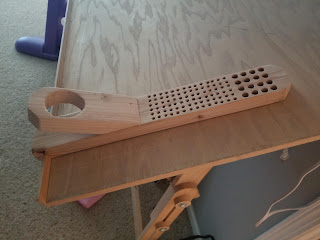I recently went through a training at work called "Building Success in You." It is designed to ingrain in us our company's leadership behaviors, so that we can champion them and push them out to our teams. As part of our closing "homework," we were told to develop a couple personal stories that we could tell that inspire our teams to follow our leadership, and that could be shared to encourage and uplift our peers.
As a result, I have been poring through some of my old blogs, because I used to write a lot about what was going on with me and in my life. I used to "tell personal stories" all the time. Since getting married and especially since having kids, I have moved away from that. When I post nowadays, it's mostly home improvement / DIY projects. In fact, other than one post, since 2016 I've posted nothing BUT home improvement / DIY projects.
And I've realized something reading those posts from mid-20s Adam. He was going through some relationship stuff when he wrote a lot of those blogs. :) I mean, I knew that, but sorry for anyone who endured Debbie Downer Adam in 2007-08 and was like, geez man. Suck it up. Move on.
 |
| My world |
Anyway, at this point in my life I am at the tail end of my 30s. I have been married for 12 years, and I have four beautiful children. Four beautiful, exasperating, fun, crazy, sweet, occasionally obnoxious, smart, and great children. Our youngest turned two in June, and we both decided that was it for us. Four is a good number - everyone has a buddy, no one has to sit in the middle seat in the back of the van, we fit around the dinner table just fine.
We started selling or giving away all of our baby stuff. We saved some sentimental things, but mostly started getting rid of it all. Bassinet, baby swings, toys, baby carriers, clothes, etc. Three of our kids are now in school during the day, so Kristen was excited to get to spend time with just our baby boy this year, and plan for what she would do once he's in school too (she would maybe like to open a bakery at some point in the future).
Then in September, I went to see my parents and help my dad out with his deck. While there, Kristen called me on Duo unexpectedly, and held up a pregnancy test.
"Are you serious?" I asked.
"Yep."
This was not what we planned.
I worry about talking about that fact. I worry that this child could grow up thinking that because they were not planned, that they are unwanted. That because we had different plans for our future, that they somehow messed up those plans. And I would say absolutely nothing about it, except for the fact that we told so many friends and family that we were done having kids, that there was no way we could play this off as intentional.This has been a trial for us. For Kristen especially, who has experienced worse "morning" (aka "all-day") sickness with this one than any of the others, and an inability to take any good medication for her still frequent headaches. For me, that means doing the majority of all household chores (cooking, cleaning, laundry, taking care of the kiddos, etc.) - as she is frequently out of commission - while still working full time (luckily from home).
A few years ago in London, I saw the play Waitress. (SPOILERS AHEAD) And while it includes some terrible messaging (i.e. infidelity with no real consequences for the two protagonists), it also has some great music and some wonderful messages of love, acceptance, overcoming abusive relationships, and...pregnancy! Specifically, the main storyline revolves around Jenna, a woman who has an unplanned pregnancy (with her abusive spouse).
Even if you know nothing about the musical, you may have heard a version of the song "She Used to Be Mine" from it. Here is the radio version by Sara Bareilles (who wrote the music for the play). In it, Jenna laments the hard circumstances in which she has found herself, and sings in part to her unborn child.
And you're not what I asked for
If I'm honest I know I would give it all back
For a chance to start over
And rewrite an ending or two
For the girl that I knew
...
And then she'll get stuck and be scared
Of the life that's inside her
Growing stronger each day
'Til it finally reminds her
To fight just a little
But then the baby comes. The penultimate song of the musical is called "Everything Changes" (I've linked it below), and I think that as parents, this is what we feel when we meet our little ones, regardless of our original plans:
Today's a day like any other
But I'm changed, I am a mother, oh, in an instant
And who I was has disappeared
It doesn't matter, now you're here
So innocent
I was lost for you to find
And now I'm yours and you are mine
...
I didn't know, but now I see
Sometimes what is, is meant to be
You saved me















































